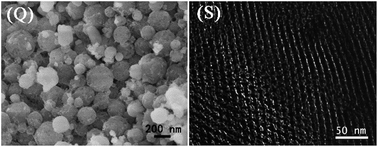High thermal stability nanocrystalline spherical mesoporous alumina (NSMA) and ordered mesoporous alumina (OMA) were synthesized in an acetic acid assisted sol–gel system by adjusting the mole ratio of n(acetic acid)/n(Al) and synthesis temperature to control the competition between the colloidal surface free energy (F) and the free energy of mesostructure self-assembly (ΔG). When F was dominant, with the mole ratio of n(acetic acid)/n(Al) set as 0.05–0.15 and the formation and aging temperature of the precursor solution set at 30 °C, the obtained alumina displayed a spherical morphology, and the nanocrystalline spherical mesoporous alumina dispersed well even when the calcination temperature increased up to 1100 °C; however, ordered mesoporous alumina was obtained with the increasing influence of ΔG when the mole ratio of n(acetic acid)/n(Al) was set as 0.10 and the lower formation and aging temperature set at 20 °C, and it retained a certain ordered structure with the specific surface area of 125 m2 g−1 even when the calcination temperature increased up to 1000 °C, which indicate the excellent thermal stability of its pore structure. Taking the as-synthesized aluminas as carriers, Pd-supported catalysts were obtained and their catalytic activity for CO and C3H6 oxidation was significantly improved compared to commercial alumina.

